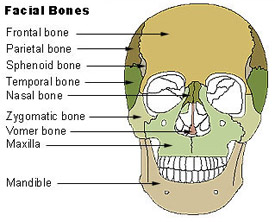A facial fracture occurs in a person who has at least one broken bones in his face. Most cases of facial fractures report injuries to the bones of the nose. Facial fractures and broken bones are covered in workplace approved training programs. To learn to manage these emergencies with hands on training with qualified instructors enrol into a course today.
Anatomy of the face
To understand how a facial fracture occurs, it helps to familiarize you with the anatomy of the face and its structures:
The following are the bones of the face:
- Mandible – lower jaw
- Maxilla – upper jaw or inner check bones
- Zygoma – outer cheek bones
- Nasal bones
- Frontal bone – forehead
The following is the anatomy of the face and its structures:
- The skull and the bones of the face
- The muscles of the face
- The nerves and arteries in the face
- The orbit
- The nasal bones
- The jaw
- The temporal artery
- The parotid gland
- The salivary glands
- The trigeminal nerve
Causes of facial fractures
- Fist fights and altercations
- Falls
- Automobile accidents
- Sports injuries
Symptoms
Symptoms of facial fractures include:
- Severe to mild facial pain
- Facial swelling: Lip swelling
- Facial bruising
- Facial tenderness – on the bone of the affected structure
- Deformity of the face: Jaw or nose
- Inability to move your eyeballs
- Changes in vision: Blurred or dual vision
- Nose bleeding
- Bilateral tingling sensation in the face
- Bilateral numbness of the face
When to seek medical attention
Seek immediate medical attention if any of the problems below occur:
- Changes in vision such as blurred or dual vision
- Delirium or confusion
- Breathing difficulty
- Inability to swallow
- Difficulty speaking
- Facial numbness
- Skin redness
- Severe and/or persistent pain
- Flattened face
- Worsening facial pain and/or swelling
- Loss of hearing
- Restricted movement of the mouth
- Malocclusion – abnormal alignment of the upper and lower teeth
- Loss of memory
- Impaired balance and coordination
- Numbness in one limb: numbness in one arm and/or numbness in one leg (unilateral)
- Weakness in one limb: weakness in one arm, weakness in one leg, weakness in both arm and leg (unilateral)
- Persistent and worsening neck pain
Treatment
Call 911 immediately if you see a casualty:
- Having breathing difficulties
- Having problems with moving his upper or lower jaw properly
- Having an improper alignment of the upper and lower jaws and upper and lower teeth
- Having an open wound on the face with an exposed bone
- Having difficulty seeing due to abnormal vision such as dual vision, blurred vision or having difficulty moving the eyeballs
1. Seek immediate medical help
- For any facial fracture such as a broken nose, a broken jaw bone, a broken eye socket or a broken cheekbone, it is important that you see a health care provider immediately to receive prompt treatment
2. Control symptoms such as pain and swelling until help arrives or until you reach the hospital
- Apply ice on the affected region to control pain and swelling
- Make sure the head is kept elevated in order to allow the blood to drain. Do not try to restrict the flow of blood or any clear, pink fluid through any natural openings such as the ear, mouth or nose
At the hospital, the doctor will examine your face with X-rays and other tests to check the severity of the damage. The bones of your face may be immobilized to help them heal properly. Take the medication as prescribed and directed by your doctor to control pain and inflammation and reduce the chances of infection.
Learn More
To learn more about broken bones and / or fractures take a workplace approved first aid and CPR course (register for a course here).

